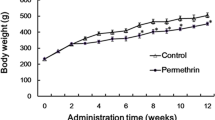Abstract
DESPITE the widespread use of DDT*, knowledge of its metabolism in vertebrates is incomplete, and is based almost entirely on experiments carried out on mammals in vivo. There have been no unequivocal reports of in vitro conversions to support these findings. Woodward, Davidow and Lehman1 have reported the disappearance of DDT from homogenized liver of rabbits injected intravenously with emulsions of DDT prior to death, but no metabolites were isolated. Judah2 incubated rat liver, kidney and diaphragm with DDT, but found no DDD or DDE and obtained only a very small conversion to DDA. Peterson and Robison3 have recently put forward a metabolic pathway for DDT in rats which was based on feeding the pesticide and its postulated metabolites, and analysing residues in the liver and kidney. In the course of these experiments, liver homogenate was incubated for 6 days with DDT, and DDD was isolated with a final ratio of DDT : DDD of 1 : 3, although, as the authors point out, this may have been due to bacterial action. No in vitro work has been reported with birds, which are probably the vertebrates most at risk from the agricultural use of DDT. We now wish to report the in vitro conversion of DDT to DDD and DDE by incubation of both homogenate and slices of pigeon liver.
This is a preview of subscription content, access via your institution
Access options
Subscribe to this journal
Receive 51 print issues and online access
$199.00 per year
only $3.90 per issue
Buy this article
- Purchase on Springer Link
- Instant access to full article PDF
Prices may be subject to local taxes which are calculated during checkout
Similar content being viewed by others

References
Woodward, G., Davidow, B., and Lehman, A. J., Indust. Eng. Chem., 40, 711 (1948).
Judah, J. D., Brit. J. Pharmacol., 4, 120 (1949).
Peterson, J. E., and Robison, W. H., Toxicol. App. Pharmacol., 6, 321 (1964).
Stadie, W. C., and Riggs, B. C., J. Biol. Chem., 154, 687 (1944).
Potter, V. R., and Elvehjem, C. A., J. Biol. Chem., 114, 495 (1936).
Taylor, A., Rea, R. E., and Kirby, D. R., Analyst, 89, 497 (1964).
Goodwin, E. S., Goulden, R., and Reynolds, J. G., Analyst, 86, 697 (1961).
Taylor, A., Analyst, 87, 824 (1962).
Miskus, R. P., Blair, D. P., and Casida, J. E., J. Agr. Food Chem., 13, 481 (1965).
Author information
Authors and Affiliations
Rights and permissions
About this article
Cite this article
BUNYAN, P., PAGE, J. & TAYLOR, A. In vitro Metabolism of p,p′DDT in Pigeon Liver. Nature 210, 1048–1049 (1966). https://doi.org/10.1038/2101048a0
Issue Date:
DOI: https://doi.org/10.1038/2101048a0
This article is cited by
-
Enzymatic detoxication of DDT to DDD by rat liver: Effects of some inducers and inhibitors of cytochrome P-450 enzyme system
Bulletin of Environmental Contamination and Toxicology (1987)
-
A novel reductive system involving flavorprotein in the rat intestine
Bulletin of Environmental Contamination and Toxicology (1978)
-
Reductive Dechlorination of DDT by Heated Liver
Nature New Biology (1972)
-
Dechlorination of p,p′-DDT in aqueous media
Bulletin of Environmental Contamination and Toxicology (1969)
-
Evidence for conversion of DDT to TDE in rat liver: II. Conversion of p,p'DDT to p,p'TDE in axenic rats
Bulletin of Environmental Contamination and Toxicology (1968)
Comments
By submitting a comment you agree to abide by our Terms and Community Guidelines. If you find something abusive or that does not comply with our terms or guidelines please flag it as inappropriate.


